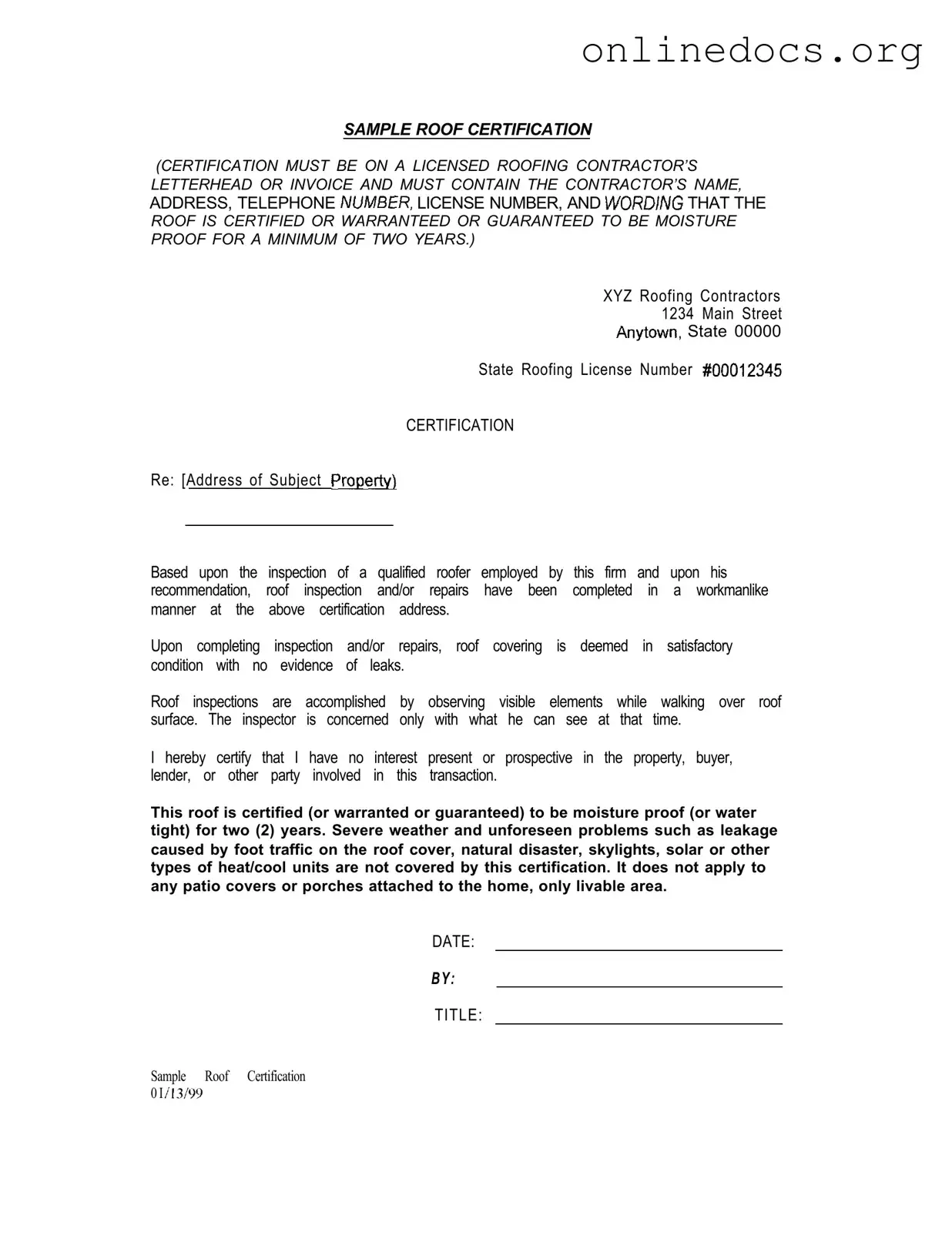The Sample Roof Certification form shares similarities with a Home Inspection Report. Both documents aim to provide assurance about the condition of a property, albeit from different perspectives. A Home Inspection Report is typically prepared by a certified home inspector who evaluates various systems within the home, including the roof. Like the Sample Roof Certification, it documents findings and may highlight areas of concern. However, while the roof certification focuses solely on the roofing system's integrity and moisture-proof status, the Home Inspection Report covers a broader range of issues, including plumbing, electrical systems, and structural components.
Another document akin to the Sample Roof Certification is the Warranty Certificate for Roofing Systems. This certificate is issued by manufacturers or contractors and guarantees that the roofing materials will perform as intended for a specific period. Similar to the roof certification, it outlines the terms and conditions of the warranty, including what is covered and the duration. However, the Warranty Certificate often includes manufacturer-specific details, whereas the Sample Roof Certification focuses on the contractor’s inspection and assurance of the roof's current condition.
When planning for future needs, individuals should also consider creating a Last Will and Testament to outline their wishes regarding property and affairs after death. This vital document, much like the All Colorado Forms, ensures that one’s intentions are legally recognized and can protect the interests of loved ones during difficult times.
A third document that aligns with the Sample Roof Certification is the Certificate of Occupancy. This certificate is issued by local government authorities and signifies that a building is compliant with all building codes and regulations. While it does not specifically address roofing issues, it indicates that the property is safe for occupancy. Both documents serve as assurances, but the Certificate of Occupancy addresses overall safety and compliance, while the Sample Roof Certification specifically ensures the roof's integrity.
Similarly, the Insurance Inspection Report is another document that bears resemblance to the Sample Roof Certification. Insurance companies often require an inspection report before issuing a homeowner's insurance policy. This report assesses the condition of the roof and other aspects of the home, much like the roof certification. However, the primary purpose of the Insurance Inspection Report is to evaluate risk for the insurer, while the Sample Roof Certification provides a guarantee of the roof's condition from the contractor's perspective.
The Roof Maintenance Agreement also shares some characteristics with the Sample Roof Certification. This agreement outlines the responsibilities of a roofing contractor to maintain and inspect a roof over a specified period. While the Sample Roof Certification provides a snapshot of the roof's condition at a particular time, the Roof Maintenance Agreement focuses on ongoing care and proactive measures to prevent future issues. Both documents emphasize the importance of regular inspections, but they serve different purposes in the lifecycle of roof care.
Another document that is similar is the Real Estate Disclosure Statement. This statement is often required during real estate transactions and discloses known issues with the property, including roof problems. While the Sample Roof Certification assures buyers of the roof's current condition, the Real Estate Disclosure Statement provides a broader context by revealing any previous issues. Both documents aim to inform buyers, but they do so from different angles: one offers a certification of condition, while the other discloses known defects.
The Property Condition Disclosure Statement is yet another document that resembles the Sample Roof Certification. This statement provides potential buyers with information about the property's condition, including the roof. Similar to the Real Estate Disclosure Statement, it may highlight any past or present issues. However, the Sample Roof Certification specifically certifies the roof's condition and moisture-proof status, giving it a more definitive assurance compared to the general disclosures found in the Property Condition Disclosure Statement.
Finally, the Building Permit Inspection Report is similar in that it documents the results of inspections conducted during construction or renovation. This report ensures that all work complies with local building codes, including roofing installations. While the Sample Roof Certification focuses on the current state of the roof, the Building Permit Inspection Report assesses compliance with regulations at the time of construction. Both documents provide important information about the property, but they serve distinct roles in the lifecycle of a building.
